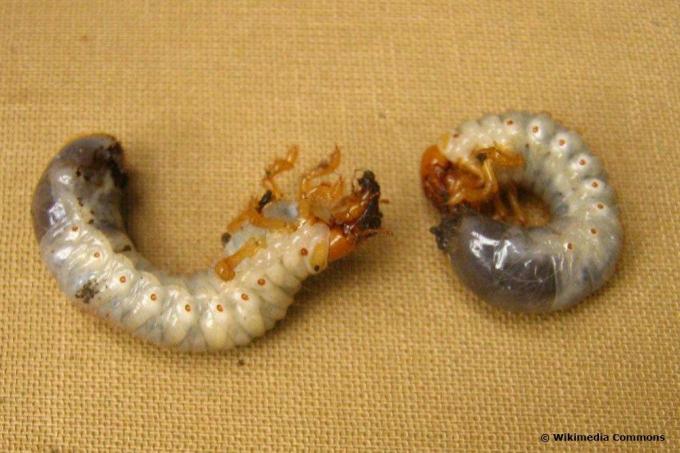
table of contents
- Appearance
- Other features
- frequently asked Questions
The cockchafer larva is one of the most dangerous pests in the garden because it mainly feeds on plant roots. If you fear and want to confirm an infestation by grubs, you need to recognize it.
In a nutshell
- Cockchafer larvae can be clearly recognized by their size
- they have 3 pairs of legs and strong mouth limbs
- most often come in white, cream or gray
- do not reside outside the earth
Appearance
The cockchafer larva can be easily recognized in your own garden due to its appearance. The larvae of the genus Melolontha are known under the term grubs, which already gives an indication of their appearance. These are quite thick caterpillars that can reach lengths of five to seven centimeters, making them a popular snack for animals such as birds and Hedgehogs power. To identify the cockchafer larva, take a look at the following list of appearance:

- Body color: white, light gray, cream, orange to brownish, more rarely black
- individual segments are provided with dark dots on both sides
- dark abdomen
- Color of the head: brown
- Shape: curved, cylindrical
- Number of pairs of legs: 3
- Kinked legs
- Pairs of legs are in the front behind the head
- Mouthparts recognizable
Note: Cockchafer larvae look very similar to the grubs of the protected rose beetle (Cetonia aurata) and rhinoceros beetle (Oryctes nasicornis). These must not be caught, killed or otherwise disturbed.
Other features
It is not just the appearance of the cockchafer larvae that provides information about them. In order to be able to distinguish them from other beetle species even more easily, you should know certain behavioral patterns. These will help identify the larvae as soon as you become aware of them. Since the cockchafer larva feeds on roots, it can only be found in the ground. They stay along the roots in order to feed on them over a long period of time. It doesn't matter whether it's an outdoor vegetable patch or a flower pot, the grubs can be found almost everywhere. The following points provide you with more information about the larvae:

- move on meandering
- always lying on your side
- sensitive to daylight
- prefer soils with little clay
- preferred depth: about 100 cm
- often curl up outside of the ground
- never stay in compost or waste
Tip: Over longer dry periods, the cockchafer larvae dig deeper and deeper into the ground until they have found a moist layer of soil. So wait until it rains before digging up the larvae.
frequently asked Questions
In appearance, rose beetle larvae did not really differ from cockchafer grubs. The characteristics of the protected larvae can only be discovered on closer inspection, including the somewhat thicker rear part. They are easier to distinguish by their whereabouts. Rose chafer larvae are mainly found in compost or in rotting wood and are beneficial insects that contribute to the better decomposition of the compost.
Since rhinoceros beetles such as rose beetles are protected in Germany, you should never injure or even kill the animals. You can recognize rhinoceros beetle larvae by their size, because they are seven to twelve centimeters tall. Otherwise they resemble the cockchafer larvae except for the eye. Pay attention to the color, because the dark areas and points on the side are not as light as on cockchafer larvae.
It takes four to five years for the grubs to pupate. During this time, the larvae eat until they have reached a certain size. For this reason there is a greater infestation by the animals in some years and there are significantly more cockchafer on the way.
Good prevention with regularly scarified beds and lawns as well as a lack of garden lighting during the night helps against cockchafer larvae. This makes it difficult for the adult cockchafer to mate and lay eggs. Already hatched larvae are attacked by predators such as birds, shrews or moles. Nematodes are also an effective measure against the grubs.



